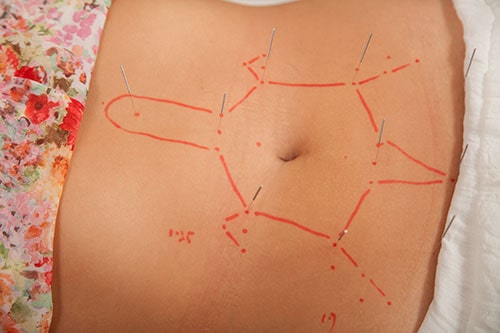In a post-opioid prescription world, there is rapidly growing interest in how acupuncture can help with the treatment of chronic pain. Chronic pain sufferers and the medical community alike are seeking reliable and effective pain management for chronic conditions including back and neck pain, osteoarthritis pain, joint inflammation and headaches. Acupuncture is used in chronic pain management to 1) provide relief from the pain itself; 2) promote healing and long term mitigation of pain through rehabilitation; and 3) support the body’s ability self-regulate by reducing inflammation, improving sleep, and aiding in digestive functions.
 Acupuncture for Pain Relief: Activating the body’s self-healing mechanisms
Acupuncture for Pain Relief: Activating the body’s self-healing mechanisms
Acupuncturists apply specific points based upon the individual’s complaint. The Chinese theory behind this practice is that stimulating specific points prompts the body to release a flow of energy, known as “qi,” and allows energy to travel through “meridians.” Meridians, in Chinese medicine, are channels that form throughout the body and through which our vital energy, qi, flows. Where energy is blocked, we have pain. Through the application of fine needles, the energy can be released and the flow restored, and pain subsides.
A ‘Western’ explanation for pain relief experienced by patients is that needles stimulate nerves that send signals to the brain and the brain releases beta-endorphins. These chemicals, when released by the brain, go to work as the body’s own opioids and lower the pain level or threshold.
Acupuncture for Healing and Rehabilitation
We often hear that acupuncture ‘helps the body heal itself.’ In terms of chronic pain, acupuncture has powerful applications as a rehabilitative modality. While the initial goal of an acupuncture treatment plan is pain relief, the longer-term initiative is to heal, mitigate, and rehabilitate the area of the body affected by chronic pain.
A rehabilitative acupuncture treatment plan enables the body to do extraordinary work. By releasing trapped energy and improving the flow of the ‘qi’ in the body, inflammation is also reduced. With less pain the cycle of inactivity, atrophy, and worsening pain can be broken. For those who suffer chronic pain, this is significant. Chronic implies that the condition will not improve and must be simply managed. However, with acupuncture and complementary integrative medicine, many patients do reverse their chronic pain conditions.
Scientific research is now revealing that acupuncture also involves the connective tissue around the acupuncture points (acupoints). Studies suggest that acupuncture’s effects may extend into connective tissue around acupoints and promote remodeling at the cellular level. In a 2018 article released by the National Center for Biotechnology Information (NCBI), researchers studying how acupuncture reduces pain took an in-depth look at the importance of connective tissue planes that surround acupuncture points.1 The results of various studies indicate that acupuncture needling reduces the mechanical stress in the tissue surrounding acupoints, thus reducing chronic pain and discomfort.
Soft Tissue Injury and Ozone Injection Therapy
Although this article discusses acupuncture for chronic pain, Ozone Injection Therapy is noteworthy and highly relevant to addressing pain at acupoints and the surrounding connective tissue. Ozone Injection Therapy greatly improves the delivery of therapeutic formulas to soft tissue injuries and has positive implications for treatment of chronic pain. For more information, visit our page on Ozone Injection for Pain Management and Healing.
Acupuncture for Supporting Sleep, Reducing Inflammation and Improving Digestion and Energy Levels
Complementary Pain Relieving and Healing Therapies
As an integrative healing therapy, acupuncture can be combined with complementary healing modalities to achieve faster, more effective results. Treatment plans for chronic pain at Chah Acutherapy are highly individual and target-specific. During the course of treatment, acupuncture therapy may be supplemented with ozone injection treatments, medical massage, cupping, CBD oil, and/or Chinese medicines, supplements or tinctures.
For sufferers of chronic pain, inflammation and disrupted sleep patterns play an enormous role in the vicious circle of inactivity, atrophy, and increasing pain, or musculoskeletal pain that surfaces in other areas of the body. Pain is a drain on energy, overall wellbeing, and emotions.
The importance of quality sleep for healing is well documented. At the cellular level, our bodies restore, recover and regenerate while we are sleeping. Well rested, we can physically and emotionally cope with challenges presented by chronic pain. Plus, while we are powered down, pain is powered down too. From the deep relaxation to light sleep that many patients experience during acupuncture treatments, to non-addictive herbal solutions that promote healthy sleep, acupuncture plus integrative Chinese medicine and/or CBD oil offers our patients a number of options for improving sleep and restoration.
Inflammation covers a broad range of both causes and symptoms of pain. Inflammation of tissue can be related to soft tissue injury, chronic conditions, disease, or illness. Integrative medicine puts a bevy of complementary solutions in the hands of acupuncture physicians and patients and allows for target-specific treatment plans. Taking a holistic approach to inflammation is logical. Rather than treat pain with a single solution, such as a prescription, holistic medicine addresses symptoms and sources of inflammation.
Finally, at first it may seem a stretch to discuss digestion and energy level in a discourse on chronic pain. However, in the context of an integrative approach to chronic pain management and healing, the elimination of waste and toxins from the body plays a supporting role. On the first visit, new patients presenting with pain from a chronic condition like lower back pain or headaches may be surprised when the acupuncture physician asks questions about sleep, digestion, stress, diet, and energy levels. During the course of treatment, the interconnections with chronic pain and the body as a whole becomes clear and follows both human logic and scientific research.
Sources
1"Cellular Reorganization Plays a Vital Role in Acupuncture Analgesia"
Conner E. Liddle and Richard E. Harris, PhD; Med Acupunct. 2018 Feb 1; 30(1): 15–20. Published online 2018 Feb 1. doi:10.1089/acu.2017.1258.
